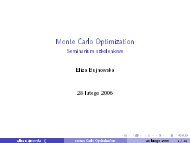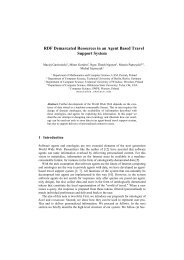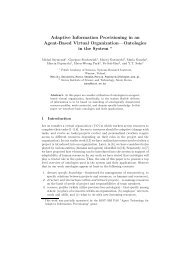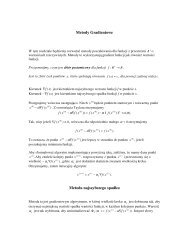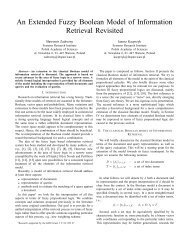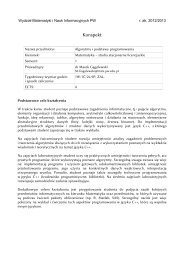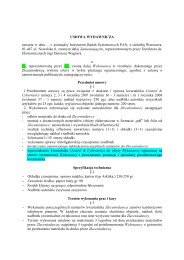Knowledge Management in an E-commerce System
Knowledge Management in an E-commerce System
Knowledge Management in an E-commerce System
You also want an ePaper? Increase the reach of your titles
YUMPU automatically turns print PDFs into web optimized ePapers that Google loves.
<strong>Knowledge</strong> <strong>M<strong>an</strong>agement</strong> <strong>in</strong> <strong>an</strong> E-<strong>commerce</strong> <strong>System</strong> 95.1.2 Model knowledgeThis knowledge concerns the models that govern our approach to <strong>commerce</strong>. These models evolve over time, albeit <strong>in</strong> asstable a progression as possible given the dynamics of e-<strong>commerce</strong>. As the system operates <strong>an</strong>d <strong>in</strong>teracts with users,suppliers <strong>an</strong>d the environment the general e-<strong>commerce</strong> models we have formulated are ref<strong>in</strong>ed until they are specificenough to br<strong>an</strong>ch <strong>in</strong> to different models, which may be applied <strong>in</strong> different situations accord<strong>in</strong>g to different cues.<strong>Knowledge</strong> of these cues <strong>an</strong>d when/how to apply the various customer, supply, etc. models to various situations is afurther abstraction of this model knowledge. Multiplicity of models results from generally accepted pr<strong>in</strong>ciple that there isnot s<strong>in</strong>gle model for <strong>an</strong>y s<strong>in</strong>gle complex problem (see for example [19]). We c<strong>an</strong> consider for example model of salestrategy that c<strong>an</strong> be enriched by add<strong>in</strong>g or remov<strong>in</strong>g some of its properties. <strong>Knowledge</strong> from this level, when allows thesystem to achieve its determ<strong>in</strong>ed goals may be sometimes used to modify the empirical knowledge (become one of thepr<strong>in</strong>ciples guid<strong>in</strong>g the system). Roughly speak<strong>in</strong>g knowledge on this level refers, for example, to different customerbehavior groups accord<strong>in</strong>g to their reaction to showed commodities advertisement.5.1.3 Situational knowledgeEmpirical <strong>an</strong>d model knowledge are not enough for the system to act <strong>an</strong>d react <strong>in</strong> a real situation, with real customers,real suppliers <strong>an</strong>d a real environment <strong>in</strong> which the system is mak<strong>in</strong>g (or los<strong>in</strong>g!) money. For this we require specificsituational knowledge. This knowledge is the lowest level of abstraction over the low-level knowledge ga<strong>in</strong>ed from thevarious sources, though it is high enough that we c<strong>an</strong> <strong>an</strong>alyze its play <strong>in</strong> the abstracted mech<strong>an</strong>isms of the system withoutreduc<strong>in</strong>g the situational knowledge to its constituent parts. This fast-ch<strong>an</strong>g<strong>in</strong>g, situational knowledge is often valid only <strong>in</strong>a given time frame <strong>an</strong>d sometimes only once (e.g. dur<strong>in</strong>g a session with a customer). Because the e-<strong>commerce</strong> system iscustomer-driven, most of these situations concern a s<strong>in</strong>gle customer, though the knowledge is not always limited to thatcustomer’s time-limited session but may sp<strong>an</strong> across sessions; here there is a problem <strong>in</strong> dist<strong>in</strong>guish<strong>in</strong>g which situationalknowledge is applicable only once <strong>an</strong>d which c<strong>an</strong> be applied multiple times.In fact, this knowledge is merely the “fill<strong>in</strong>g” for the model knowledge, which describes our general approach to theclient. If our bus<strong>in</strong>ess/customer model proscribes a certa<strong>in</strong> approach (e.g. especially obtrusive advertis<strong>in</strong>g), then thesituational knowledge for accomplish<strong>in</strong>g this model-def<strong>in</strong>ed objective will never come <strong>in</strong>to play. At a certa<strong>in</strong> dist<strong>an</strong>cefrom both the situational <strong>an</strong>d model knowledge effects on the <strong>in</strong>teraction with the customer is empirical knowledge,which casts a more subtle but nevertheless signific<strong>an</strong>t <strong>in</strong>fluence on the delivery of the system to the customer. We willnot advertise <strong>an</strong> item which we do not have access to a stock of, or <strong>an</strong> item that doesn’t exist. World knowledge placesthese constra<strong>in</strong>ts on our model knowledge, so that these possibilities never enter the picture of how the system functions.Here we must recognize that though the world knowledge constra<strong>in</strong>s the model knowledge which itself constra<strong>in</strong>ts thesituational knowledge, the latter are not subsets of the former, <strong>an</strong>d <strong>in</strong> fact, the relationship between them (or <strong>an</strong>yknowledge) c<strong>an</strong>not be described by sets or even object hierarchies. The relationships are cascad<strong>in</strong>g cause <strong>an</strong>d effect. Inaddition, there is a feedback loop between all three, which allows situational or model knowledge to affect worldknowledge, situational to affect model, etc. though this loop is highly restra<strong>in</strong>ed to prevent time- or other contextdependentvariables from affect<strong>in</strong>g more const<strong>an</strong>t factors.5.2 EconomicFrom this perspective, the e-<strong>commerce</strong> system may be considered solely as a market entity. The ontology of this viewdescribes the r<strong>an</strong>ge of economic laws <strong>an</strong>d theories as well as practical models of enterprise org<strong>an</strong>ization, specificallyapplied to the e-<strong>commerce</strong> doma<strong>in</strong>. Like <strong>an</strong>y other economic entity, the e-<strong>commerce</strong> system has <strong>in</strong>come, cost, profits aswell as economic strategies. This is the perspective of the economist, <strong>an</strong>d may be used to <strong>an</strong>alyze <strong>in</strong> relation to othermarket players, traditional or electronic.5.3 PersonalizationThe knowledge m<strong>an</strong>agement processes of <strong>an</strong> e-<strong>commerce</strong> system <strong>an</strong>d the knowledge that they operate on may be seen as<strong>an</strong> eng<strong>in</strong>e for personalization of user content. Some of the motivations <strong>an</strong>d mech<strong>an</strong>isms for reach<strong>in</strong>g this end through theuse of knowledge have been described previously; <strong>in</strong> earlier works [10, 23, 24] we describe some specific me<strong>an</strong>s towardInternational Conference on Electronic Commerce Research (ICECR-5)



